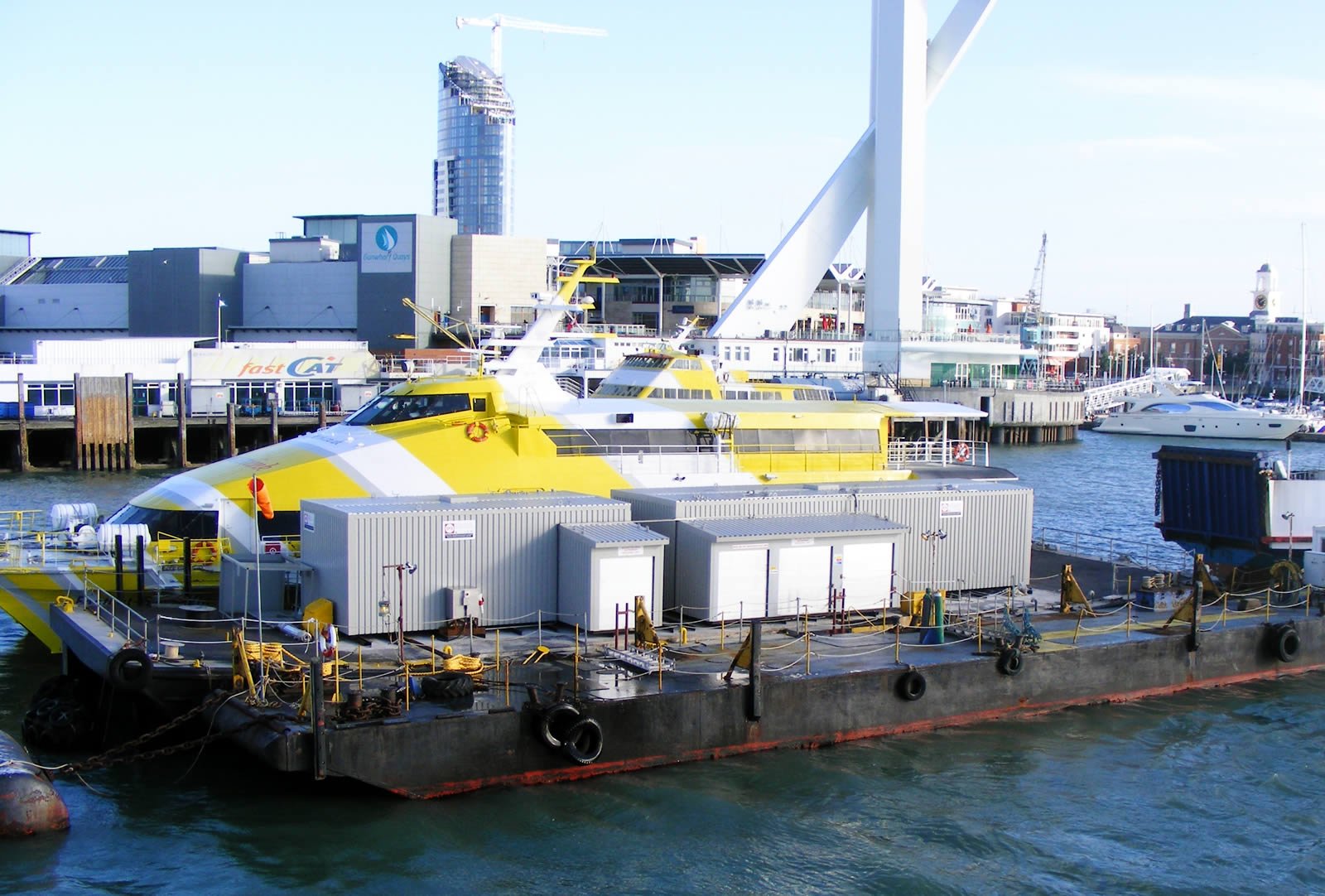
Fuel Pontoon Helps to Keep Wightlink Ferries on Time
The commissioning of a floating fuel storage platform by Wightlink Ferries has delivered two significant operational benefits. Firstly it has secured the provisioning of marine low-sulphur fuel oil, delivered by sea-going ‘bunker’ tankers. Secondly, it is helping to ensure the reliability of Wightlink’s daily services, by enabling its ferries to fuel on-demand and at off peak times, allowing more flexibility and maximum availability.
-
The investment project was initiated by the local fuel oil supplier, John H Whitaker Tankers, which is based in Eastern Docks, Southampton. Whitaker specialises in providing ship refuelling – or bunkering services, a maritime term derived from the days when ships were powered by coal.
Today Whitaker operates as a national distribution partner for the major oil companies such as ExxonMobil, provisioning marine grade fuels to ships visiting such ports as Southampton and Portsmouth.
-
“By their nature the Wightlink ferries are busy little ships, operating more or less continuously throughout each day,” explains Whitaker’s general manager, Ashley Jenkins. “They therefore tend to require frequent re-fuelling compared to larger vessels such as cruise liners which will take much larger fill ups at longer intervals.”
“As a logistics operation Whitakers has to forecast and plan capital expenditure over the long term in order to match its resources to changing operational requirements.
Over recent years the Whitaker fleet in Southampton has been reconfigured to a smaller number of larger capacity tankers. This has provided economies of scale and greater efficiency in operating costs, but unfortunately this adjustment also diminished our ability to service a ferry operation demanding frequent deliveries of relatively small amounts.”
“There was a mismatch of availability because the ferries would be taking up to ten deliveries a week across all the fleet. This was further complicated by the need often to fuel very late at night to fit in with the ferries’ operating schedules.
“Obviously our refuelling tankers can only be in one place at a time and the crews are subject to strict regulations governing working hours. Whilst we didn’t want to lose a valuable customer, the Wightlink account was beginning to become a logistical headache.”
For Wightlink the only alternative would be to switch over to a more expensive grade of marine gas oil, (red diesel), which can be delivered by road transport. This was not an attractive proposition since it would increase the fuel bill potentially by more than 50 percent.
-
An obvious solution would be to provide a buffer store with self service facilities, essentially drawing from standard practice used in the road transport sector. As well as operational benefits, a large capacity storage tank would allow greater control over fuel costs by enabling the customer to negotiate better prices for bulk deliveries.
Since quayside facilities are very limited in Portsmouth, Wightlink was already using a fixed mooring within Portsmouth harbour for refuelling by Whitaker’s bunker barges. By chance of foresight, these moorings also included an ex-NATO dumb barge which had been purchased some years before and was being used for general storage.
The barge had been used previously as a helicopter landing platform and its deck had been covered with tarmac. An initial survey showed that it was structurally sound and stable enough to be used to support a floating fuel oil storage facility. A study was launched to work out the optimum tank capacity and also the implications for setting up an oil storage facility within such a highly sensitive marine environment.
-
“Clearly fuel oil is potentially a marine pollutant, and storing it on open water is something that had to be looked at very carefully. We began a lengthy consultation with the harbour authorities to explain our proposals and Wightlink called in their own naval architects to design the barge’s structural modifications to ensure that it could do the job.
“Having satisfied the harbour authorities that it was a viable project we then set out to find a supplier with the expertise and resources we needed to design and manufacture the storage tanks. As well as the primary fuel oil for propulsion, a second tank was needed for the higher grade marine gas-oil used by the ferries’ generators and refrigeration plant.
“Oil Tank Supplies (OTS) of Moreton-in-Marsh was the obvious choice for this commission,” Ashley Jenkins continues. “Although this was new territory for Whitaker Tankers, we had other ferry clients who had worked successfully with OTS for many years, and we knew they were very experienced with similar, (but shore based) installations at the local ferry port.”
OTS was very enthusiastic as this was quite an unusual job – meeting very specific requirements for a floating platform. They fully understood the requirements set out by the design specification and associated risk assessment for the installation.
Detailed technical proposals together with cost estimates were provided by OTS to Wightlink for a self contained facility based on two fully bunded storage tanks, each incorporating the dispensing pumps, hose reels and effective process control equipment.
“Whitaker Tankers’ primary role from this point was to facilitate the project in its marine aspect. We were responsible for the shipping logistics and we had to satisfy the local port authorities that this was a safe operation and that we could service it professionally going forward,” says Ashley Jenkins.
“In consultation with Wightlink and OTS we calculated that the safe operational storage capacity would be 146 m3litres of fuel oil and 79 m3 of gas oil. This capacity included considerable safety margin to prevent any possibility of overfilling the tanks.”
“Also as there were two tanks on a floating platform we had to take into account the effect on trim – fore and aft – for different amounts of contents within each tank – the worst case scenario being the larger tank full and the small tank empty. The naval architects factored all manner of stress and stability calculations to ensure that no permutation would cause a problem. They did a great job as our subsequent experience has proven it to be a very stable platform.”
The barge was brought to Southampton for refurbishment and fitting out by a local shipyard. Final stage was the delivery of the tanks to Eastern Docks where they were craned aboard the barge, all equipment secured and the barge towed back to Portsmouth for training and trials.
Each tank is a self contained dispensing facility with flow rate meter, delivery pump, hose reel and tank to tank connections. In addition to this each of the tanks is fitted with alarms to provide an additional line of defence and the tank design incorporated 110 percent capacity bunds, to contain any leakage.
In operation, filling procedures are monitored by experienced and qualified crew and the process is strictly controlled to ensure absolutely no risk of spills from the tank.
-
“Having installed the floating tank, fuel replenishment is now a straightforward process. We simply top up the tank as and when required and the ferry crews take bunkers at their convenience and times to suit their busy schedule. After initial training by OTS staff, the ferry crews were competent to handle refuelling by themselves and they have adopted the procedure without any difficulties.
The changeover to self-refuelling went smoothly and has now become part of the operational routine for Wightlink ferries. The platform has now been in service for over three years without any problems. From the point of view of customer service, we have had excellent feedback; it really has been a win – win result all round.
“We work on the basis of a flawless performance, so there is zero tolerance – nothing is allowed to spill into the water,” stresses Ashley Jenkins, adding; “Every joint is enclosed and isolated from the environment. We would not put our name to this if there was any undue risk.”
Ashley concludes by saying: “To reassure the Port Authority, we determined from the outset the importance of appointing a highly professional and reputable tank storage specialist – OTS – who continue to provide on-going service support. Protection of the environment is paramount and we couldn’t find a company better qualified to support this project. With OTS we knew that all equipment would be designed and manufactured to the very highest standards and in full compliance with the latest regulations – in excess of that in fact – so we can be confident that the system is future proof.”
Commenting on the Wightlink project, OTS Chief Executive, Bruce Woodall said:
“As fuel storage specialists, a marine installation represents the ultimate challenge, where the protection of the environment is paramount.”“Now one of our largest dual tank installations, the Wightlink fuelling station was a great opportunity to showcase our engineering and design capabilities – working in partnership with Whitaker Tankers to deliver a sustainable solution, which in turn has enabled the end-user customer to achieve greater operational efficiencies.”


